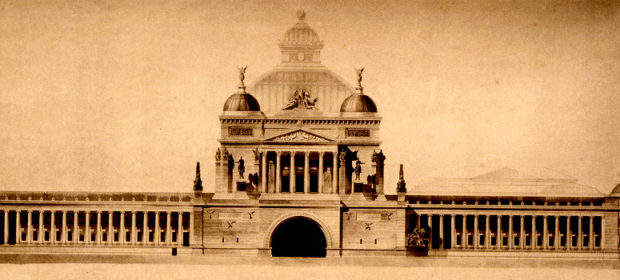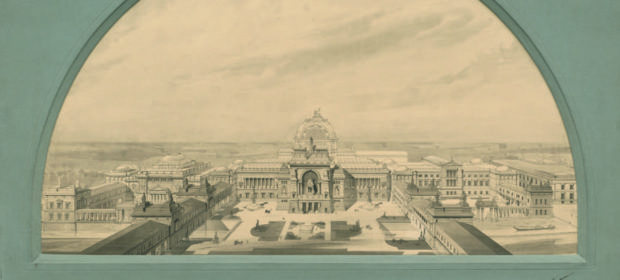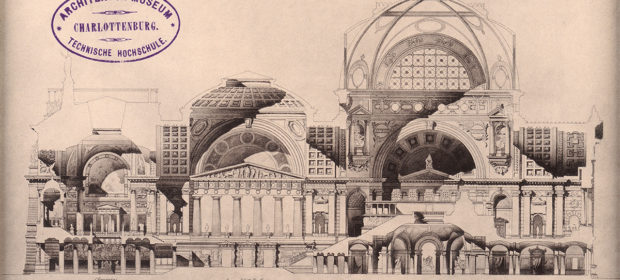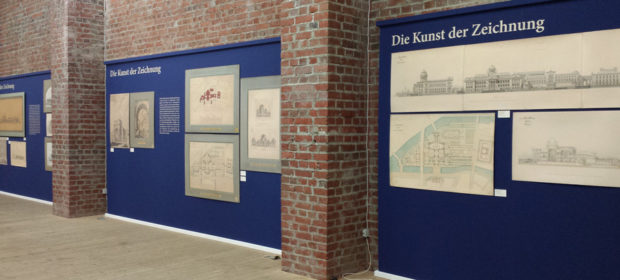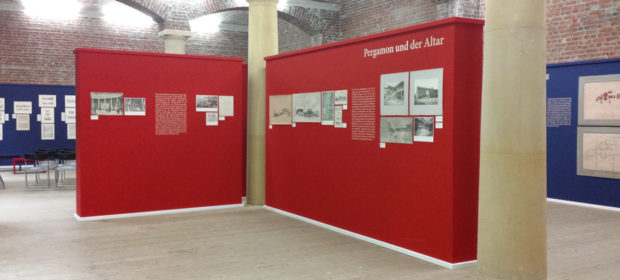MuseumsVisionen — Eine Ausstellung zum großen Museumsinselwettbewerb von 1883
Die Ausstellung “Museumsvisionen. Der Wettbewerb zur Erweiterung der Museumsinsel 1883/84” rekonstruierte den Architekturwettwerb zur Erweiterung der Museumsinsel in architektur- und kulturhistorischer Hinsicht. Die Ausstellung und ein Begleitband wurden im Rahmen eines Projektseminars von Studierenden konzipiert; die Projektleitung hatten Bénédicte Savoy, Professorin für Kunstgeschichte an der Technischen Universität Berlin, und Nikolaus Bernau, Architekturhistoriker und -kritiker, in Kooperation mit Hans-Dieter Nägelke, Leiter des Architekturmuseums der TU Berlin. Das Ausstellungsdesign wurde gemeinsam mit Studierenden des Studiengangs Bühnenbild_Szenischer Raum der TU Berlin unter der Leitung von Johann Jörg entwickelt. vom 17. September bis 11.Oktober 2015 war die Ausstellung in Berlin-Mitte in der Bauakademie am Schinkelplatz zu sehen.
Exhibition Concept
in English
Prior to 1871, the international importance of Berlin museums had been limited at best. But with the founding of the German Reich, Berlin’s collections began growing so quickly as to compete with those of London, Paris and St. Petersburg. A steady stream of special grants by the Prussian House of Representatives, combined with rapid increases in operating budgets and support from the disposition fund of King and Emperor Wilhelm I laid the fiscal foundations. Symbols of the rise of Berlin’s museums to international prominence were found in the acquisition of the Pergamon Altar frieze due to excavations beginning in 1878 and in the castings and other findings of the “Reich excavation” in Olympia. The existing buildings on Museum Island—the Altes Museum, Neues Museum and Nationalgalerie—could hardly accommodate the new additions. Nor was the situation remedied by the relocation of ethnological and prehistoric collections to the Ethnological Museum, a new institution conceived in 1879. As a result, in July of 1883 the Prussian Ministry of Culture advertised an architectural competition for the further development of Museum Island. Fifty-two architects from the German-speaking world submitted blueprints for new buildings that were to house originals from excavations at Pergamon and elsewhere, casts from Olympia, the world’s largest collection of casts of ancient and early modern sculpture, the Gemäldegalerie and a collection of original, early modern sculptures. Their designs range from a monumental structure for the Pergamon Altar resembling a train station and presiding over the city railway to Neo-Baroque plans reminiscent of concert houses and vast spatial orchestrations that would exhibit the facades of the Temple of Zeus at Olympia and casts of the most famous monuments of antiquity. The competition became a panorama of what was currently under debate in European architecture and museology; it drew stimulus from Paris and London and processed findings from excavations; and like the second Reichstag competition it signalized the breakthrough of the Italianizing Neo-Renaissance style in the state architecture of the German Reich.
In presenting the different designs, this multimedia exhibition drew on the extensive holdings of the Museum of Architecture of the TU Berlin, on museums and archives in Berlin, Vienna, London and Paris and on Private collections. Reports and previously unreleased private notes from that period provided visitors with a view of how the first-class competition jury arrived at their decision and how the competition advertisement was received in the press and in professional circles. The central theme of the exhibition was the presentation of antiquities, casts and architecture on a 1:1 scale. As such, the exhibition tied in directly with questions examined by Topoi research group (C-3) Fragments, Ruins and Space: The Perception and Representation of Ancient Spaces in Modern Contexts. It also sought to show why, despite the event itself having been largely forgotten, the effects of the Museum Island competition of 1883 continue to be felt to this day, from the construction of the Bodemuseum and Pergamonmuseum to the new James Simon Gallery — a visitor center designed by David Chipperfield that is currently under construction.
A catalog prepared by students and lecturers as part of a Topoi-funded project at the TU Berlin accompanied the exhibition. It features architectural and cultural-historical commentary on the competition:
ZEITRAUM
17. September bis 11. Oktober 2015.
Ausstellungseröffnung: 16. September 2015
Ort
Musterraum der Bauakademie
Schinkelplatz 1
10117 Berlin
Germany
Das Buch zur Ausstellung
Begleitend zur Ausstellung erschien im Verlag Ludwig ein reich illustrierter Bildband, der den Wettbewerb erstmals umfassend wissenschaftlich dokumentiert.
Nikolaus Bernau, Hans-Dieter Nägelke and Bénédicte Savoy (Eds.),
Museumsvisionen. Der Wettbewerb zur Erweiterung der Berliner Museumsinsel 1883/84,
Kiel: Verlag Ludwig, 2015
Leitung / Konzeption
Prof. Dr. Bénédicte Savoy (Kunstwissenschaft TU Berlin)
Dr. Hans-Dieter Nägelke (Leiter Architekturmuseum TU Berlin)
Nikolaus Bernau (Senior Fellow Topoi)
Unter Mitarbeit von
Mei-Hau Kunzi
Merten Lagatz
Moritz Dapper
Forschungsprojekte
Topoi-Projekt (C-3) Fragments, Ruins and Space: The Perception and Representation of Ancient Spaces in Modern Contexts
Projektseminar “Museumsvisionen” an der TU Berlin
Pressestimmen
- Rezension im Tagesspiegel vom 26. September 2015 (PDF | 270,4 KB)
- Rezension in der Frankfurter Allgemeinen Zeitung vom 29. September 2015 (PDF | 2,2 MB)
- Rezension in der Berliner Zeitung vom 30. September 2015 (PDF | 227,5 KB)
- Bénédicte Savoy im Interview, DRadio Kultur am 16. September 2015 (MP3 | 6,7 MB)
- Bénédicte Savoy im Interview, Deutschlandfunk am 16. September 2015 (MP3 | 4,9 MB)

